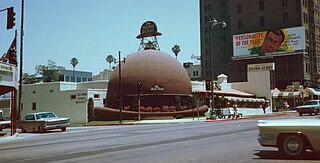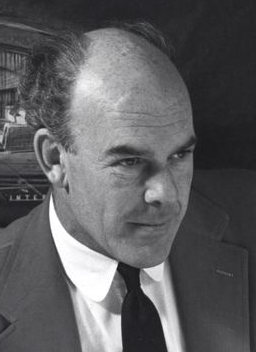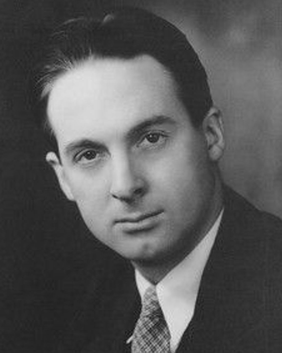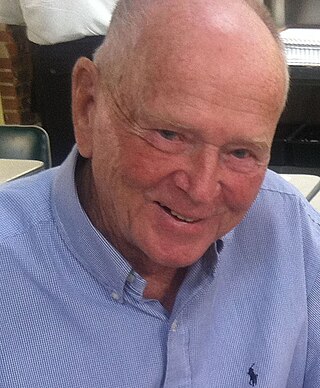
Googie architecture is a type of futurist architecture influenced by car culture, jets, the Atomic Age and the Space Age. It originated in Southern California from the Streamline Moderne architecture of the 1930s, and was popular in the United States from roughly 1945 to the early 1970s.

Brown Derby was a chain of restaurants in Los Angeles, California. The first and best known was shaped like a derby hat, an iconic image that became synonymous with the Golden Age of Hollywood. It was opened by Wilson Mizner in 1926. The chain was started by Robert H. Cobb and Herbert K. Somborn in the 1920s. The original Brown Derby restaurants had closed or had been converted to other uses by the 1980s, though a Disney-backed Brown Derby national franchising program revived the brand in the 21st century. It is often incorrectly thought that the Brown Derby was a single restaurant, and the Wilshire Boulevard and Hollywood branches are frequently confused.

John Edward Lautner was an American architect. Following an apprenticeship in the mid-1930s with the Taliesin Fellowship led by Frank Lloyd Wright, Lautner opened his own practice in 1938, where he worked for the remainder of his career. Lautner practiced primarily in California, and the majority of his works were residential. Lautner is perhaps best remembered for his contribution to the development of the Googie style, as well as for several Atomic Age houses he designed in the late 1950s and early 1960s, which include the Leonard Malin House, Paul Sheats House, and Russ Garcia House.

Mel's Drive-In is a term referring to two American restaurant chains, successors of a restaurant founded in 1947 by Mel Weiss and Harold Dobbs in San Francisco, California. It is closely associated with the film American Graffiti.

Wayne Douglas McAllister was a Los Angeles-based architect who was a leader in the Googie style of architecture that embraced the automobile and the Space Age. Inspired by tail fins and gleaming chrome, he elevated the drive-in restaurant and the theme hotel to futuristic works of art. His 1941 El Rancho Vegas was the very first resort hotel on the Las Vegas Strip, and his iconic 1949 Bob's Big Boy restaurant in Burbank, California is a California historical landmark. He created iconic circular drive-in restaurants in Southern California, including Simon's, Herbert's, and Robert's in the 1930s.

Norms Restaurants is a regional chain of diner-style restaurants in Southern California. Founded in 1949 by used-car salesman Norm Roybark, some restaurants are open 24 hours a day, 7 days a week. As of April 2024, the company operates 23 locations in Greater Los Angeles, with plans to expand into Las Vegas, Nevada.
Stonewood Center, sometimes referred to as Stonewood Mall, is a shopping mall located in Downey, California, which is one of the Gateway Cities of Southeastern Los Angeles County. It is located at the intersection of Firestone and Lakewood Boulevards, and it is from this intersection that the mall's name is derived. It is within a few miles of many freeways in the area: I-5 and I-605, I-710 and I-105 freeways. The mall is owned and operated by The Macerich Company and is part of its trifecta of malls in southeast Los Angeles County along with the Los Cerritos Center in Cerritos and the Lakewood Center in Lakewood. Stonewood Center comprises 145 stores, including several restaurants.

Bob's Big Boy is a casual dining restaurant chain founded by Bob Wian in Southern California in 1936, originally named Bob's Pantry. The chain's signature product is the Big Boy hamburger, which Wian created six months after opening his original location. Slicing a bun into three slices and adding two hamburger patties, Wian is credited with creating the original double-decker hamburger.

Pann's is a coffee shop restaurant in the Westchester neighborhood of Los Angeles, California, known for its history, role in movies, and distinctive architecture. The restaurant was opened by husband and wife George and Rena Poulos in 1958. It is also known for its neon sign, Googie architecture, and 1950s decor. The building and its iconic neon sign were designed by architects Eldon Davis and Helen Liu Fong of the Armet & Davis architectural firm. Pann's remains one of the best preserved examples of Davis' Googie designs, according to the Los Angeles Times.
Armet Davis Newlove Architects, formerly Armét & Davis, is a Californian architectural firm known for working in the Googie architecture style that marks many distinctive coffee shops and eateries in Southern California. The firm designed Pann's, the first Norms Restaurants location, the Holiday Bowl and many other iconic locations.

The Holiday Bowl was a bowling alley on Crenshaw Boulevard in Los Angeles, California. It was founded in 1958 by five Japanese-Americans and was a significant part of the rebuilding process of the Nikkei community after internment during World War II. The owners of the Holiday Bowl sold shares throughout the community to finance its construction."

Wich Stand was a '50s-style coffee shop restaurant and diner in Los Angeles, California, featuring a tilting blue roof and 35-foot spire (11 m), designed by architect Eldon Davis.

Johnie's Coffee Shop is a former coffee shop and a well-known example of Googie architecture located on the corner of Wilshire Boulevard and Fairfax Avenue in Los Angeles, California. Architects Louis Armét and Eldon Davis of Armét & Davis designed the building, contributing to their reputation as the premier designers of Space Age or Googie coffee shops—including the landmark Pann's coffee shop in Ladera Heights, Norms Restaurant on La Cienega Boulevard, and several Bob's Big Boy restaurants.

Eldon Carlyle Davis was an American architect, considered largely responsible for the creation of Googie architecture, a form of modern architecture originating in Southern California. Googie architecture is largely influenced by Southern California's car culture and the Space Age of the mid-20th century. Davis was a founding partner of the Armet & Davis architectural firm which championed Googie architecture, including the original Norms Restaurant, a Googie coffee shop designed by Davis. For his work, the Los Angeles Times called Davis, "the father of the California coffee shop."

Ships Coffee Shop was a small chain of coffee shops with iconic Modern architecture in Los Angeles, California. The architectural style is classified as Googie Architecture. Ships was especially known for its signage. Martin Stern Jr. was the architect.

Helen Liu Fong was an American architect and interior designer from Los Angeles, California. Fong was an important figure in the Googie architecture movement, designing futuristic buildings like Norms Restaurant, the Holiday Bowl, Denny's, Bob's Big Boy, and Pann's Coffee Shop that helped usher in an era of boomerang angles, dynamic forms and neon lights. Fong became one of the first women to join the American Institute of Architects, and worked with Armet and Davis on many of her most well-known projects. Many of Fong's best-known building designs feature large glass fronts and bold colors on interior walls, designed to stand out and entice potential customers.
Googie's Coffee Shop was a small restaurant located at 8100 Sunset Boulevard in Los Angeles next door to the famous Schwab's Pharmacy at the beginning of the Sunset Strip. It was designed in 1949 by architect John Lautner and lent its name to Googie architecture, a genre of modernist design in the 1950s and 60s. Interest in the style was revived by the 1986 book Googie: Fifties Coffee Shop Architecture by Alan Hess.
Tiny Naylor's was a restaurant chain in Southern California started in 1949 by William Wallace "Tiny" Naylor and later run by his son Biff Naylor. W.W. Naylor had previously owned more than a dozen Tiny's Waffle Shops in Central California. Naylor moved to Los Angeles and hired architect Douglas Honnold to design an eye-catching drive-in restaurant at the corner of Sunset Boulevard and La Brea Avenue in Hollywood. Actor Humphrey Bogart compared the slanted canopy roof of the building to "a huge bird about to take off.". The restaurant featured Googie architecture and carhop service, and claimed to be the birthplace of the Patty melt. Naylor died on August 17, 1959, while at the Del Mar racetrack. The original location closed on March 11, 1984 and was demolished. The site is currently a shopping center.
Ben Frank's was a restaurant in West Hollywood, California, opened in 1962 by Arthur Simms and Bob Ehrman. The location, surrounded by the famous nightclubs of the Sunset Strip, led to a celebrity clientele, and the 24-hour restaurant became a popular late night destination. The distinctive googie architecture and eye-catching neon sign helped attract musicians like Jim Morrison and Frank Zappa, as well as patrons of the nearby music venues. The youthful patrons that frequented the restaurant inspired the producers of the Monkees TV show to place an ad seeking "spirited Ben Frank's types" when casting the show in 1965.

Fatima's Grill is a restaurant specializing in Lebanese and Mexican fusion cuisine. First opened as a taco stand in 2016, its main location is presently located at 7840 Firestone Boulevard in Downey, California, part of the Gateway Cities region of Los Angeles County.



















